最近在学习深度学习有关的知识,这里记录一个实战练习,供自己理解学习,也提供给大家学习。这里我用的工具是VSCode,数据集可以自己到网站爬取清洗到数据库下载,这个是公开的,也没有什么反爬机制。当然了,考虑到方便小伙伴们的学习,大家可以自行下载我爬取到的数据集~
https://download.youkuaiyun.com/download/luoying189/92265792?spm=1001.2014.3001.5503
话不多说,我们开始实战。
一、数据的预处理
新建py文件:aqi_train.ipynb
1、导入需要的包
import numpy as np
import pandas as pd
import matplotlib.pyplot as plt
from sklearn.preprocessing import MinMaxScaler
from sklearn.model_selection import train_test_split
import keras
from keras .layers import Dense
from tensorflow.python.keras.utils.np_utils import to_categorical
from sklearn.metrics import classification_report
plt.rcParams['font.sans-serif']=['SimHei'] # 用来正常显示中文标签
plt.rcParams['axes.unicode_minus']=False # 用来正常显示负号
import warnings
warnings.filterwarnings("ignore")
2、导入数据集,可以看到我们的数据集有6个特征,1个标签(AQI)
dataset = pd.read_csv('aqi.csv')
dataset
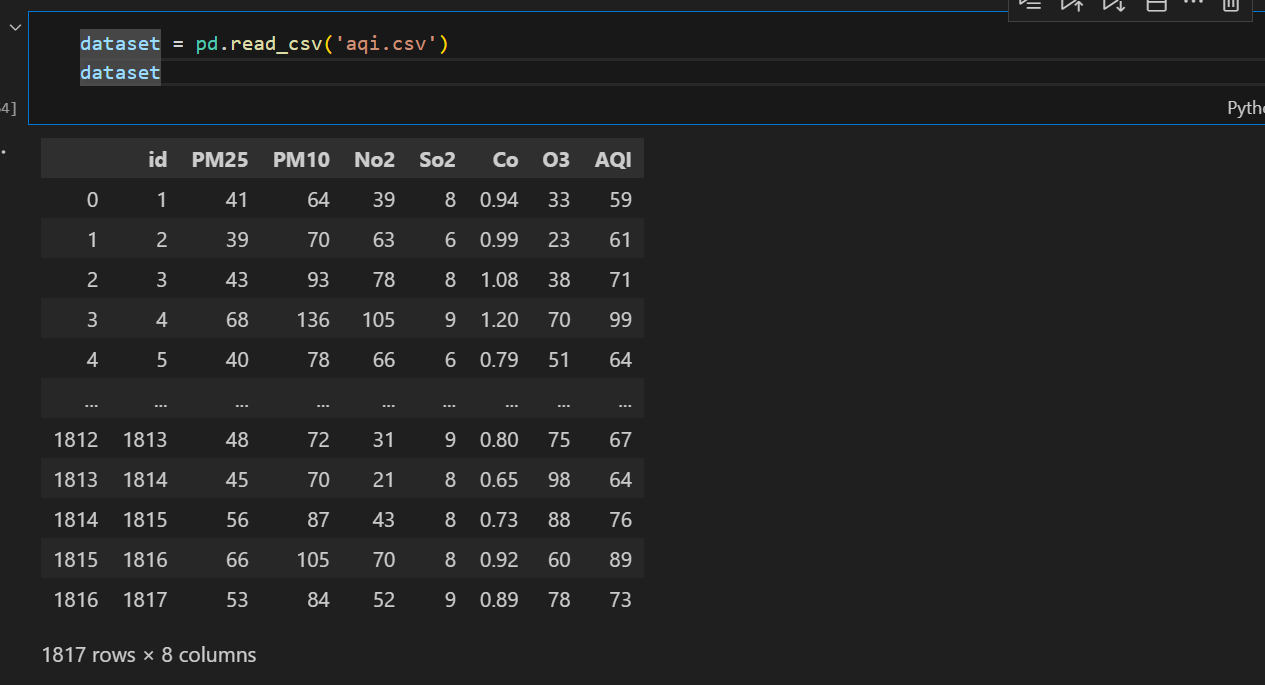
3、划分特征与标签
X = dataset.iloc[:,1:-1]
Y = dataset['AQI']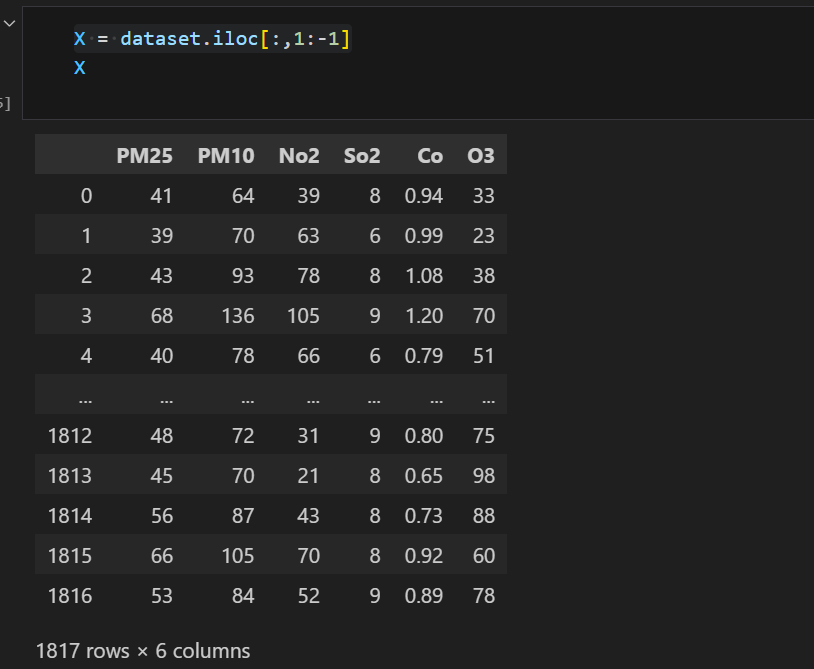
4、划分训练集和测试集,这里我们划分为8:2
x_train,x_test,y_train,y_test = train_test_split(X,Y,test_size=0.2,random_state=42)
5、将数据进行归一化,为什么要进行数据的归一化呢?归一化的核心目的是让所有特征处于同一“量纲”或“尺度”上,从而保证模型能够公平、高效地学习。
举个小例子:
当我们预测房价的时候,特征A:房间面积:90-250平方米,特征B:房间数量1-6个。这两个特征的数值范围相差巨大。如果不进行归一化,模型(尤其是基于距离的算法如KNN、SVM,或使用梯度下降的算法)会认为“房间面积”这个特征因为数值更大,所以更重要,给予的权重也会更大。这显然是不合理的,因为房间数量同样是一个重要的预测因素。
比如,你会买一个200平方米但是只有一个房间的房子吗?大部分人不会买吧?这种房子显然在房子市场不那么受欢迎(当然也不是那么绝对,只是大部分人不会选择,如果我发财了我也会买大房子自己住的~~),但是如果不给予合适权重,就会因为面积大而被刻板标榜高价。
# 数据归一化
sc = MinMaxScaler(feature_range=(0,1))
x_train = sc.fit_transform(x_train)
x_test = sc.transform(x_test)
y_train = pd.DataFrame(y_train)
y_train = sc.fit_transform(y_train)
y_test = pd.DataFrame(y_test)
y_test = sc.transform(y_test)
x_train = x_train.reshape(-1, x_train.shape[-1]) # 或 .values.reshape(-1, n_features)
x_test = x_test.reshape(-1, x_test.shape[-1])
y_train = y_train.reshape(-1, 1)
y_test = y_test.reshape(-1, 1)
二、模型建立与训练
1、模型建立,我们添加两个隐藏层,激活函数选择“relu”,由于并不是分类任务,所以输出层输出单个数值就好。
model = keras.Sequential()
model.add(Dense(10,activation='relu'))
model.add(Dense(10,activation='relu'))
model.add(Dense(1))
2、模型编译
model.compile(loss='mse',optimizer='SGD') #SGC随机梯度
3、模型训练,我们训练100轮次,最后保存我们的模型,为了后面的检测
history = model.fit(x_train,y_train,epochs=100,batch_size=24,verbose=2,validation_data=(x_test,y_test))
model.save('aqi_model.keras')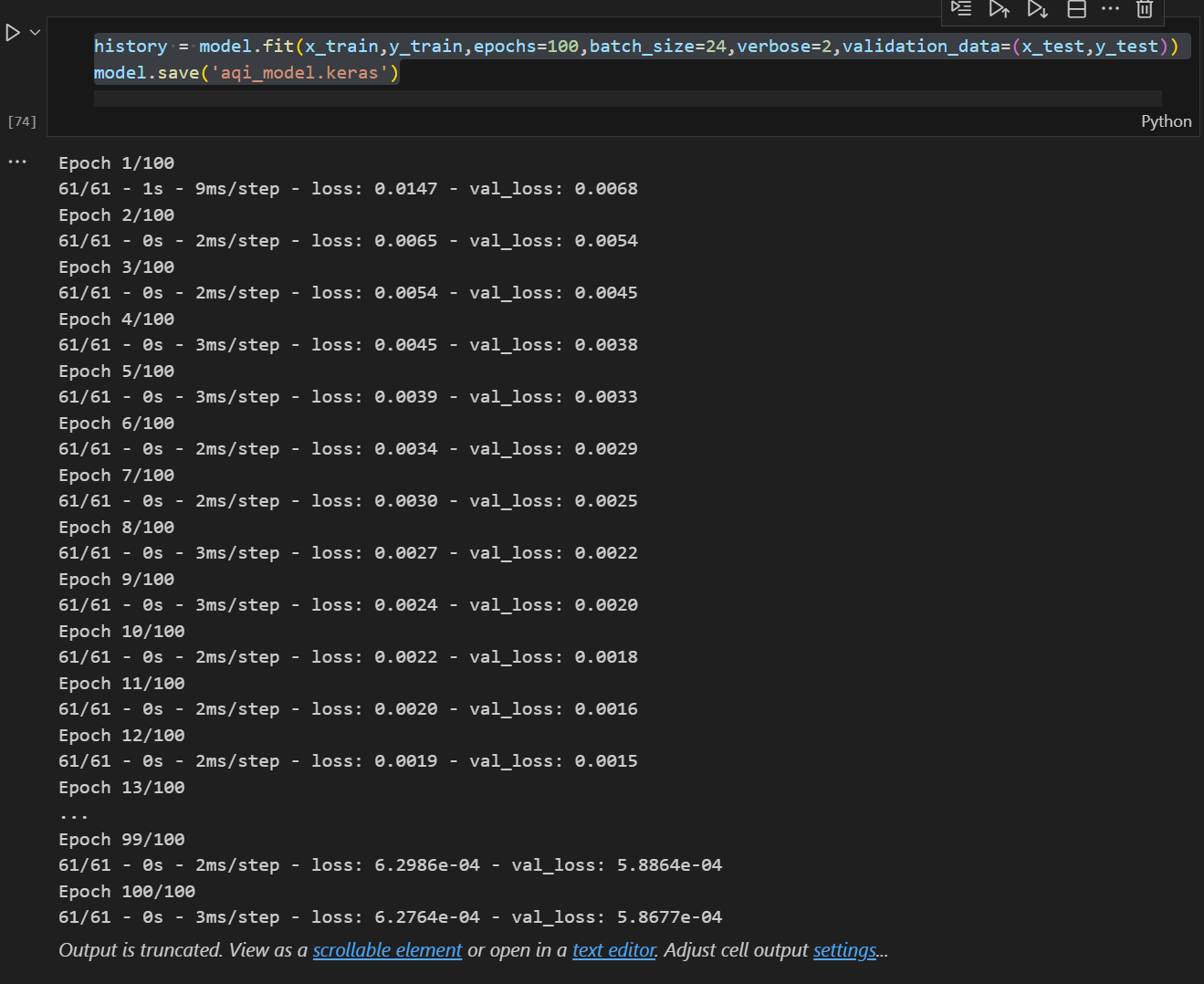
三、模型损失值的可视化
plt.plot(history.history['loss'],label='train')
plt.plot(history.history['val_loss'],label='val')
plt.title('全连接神经网络loss值图')
plt.legend()
plt.show()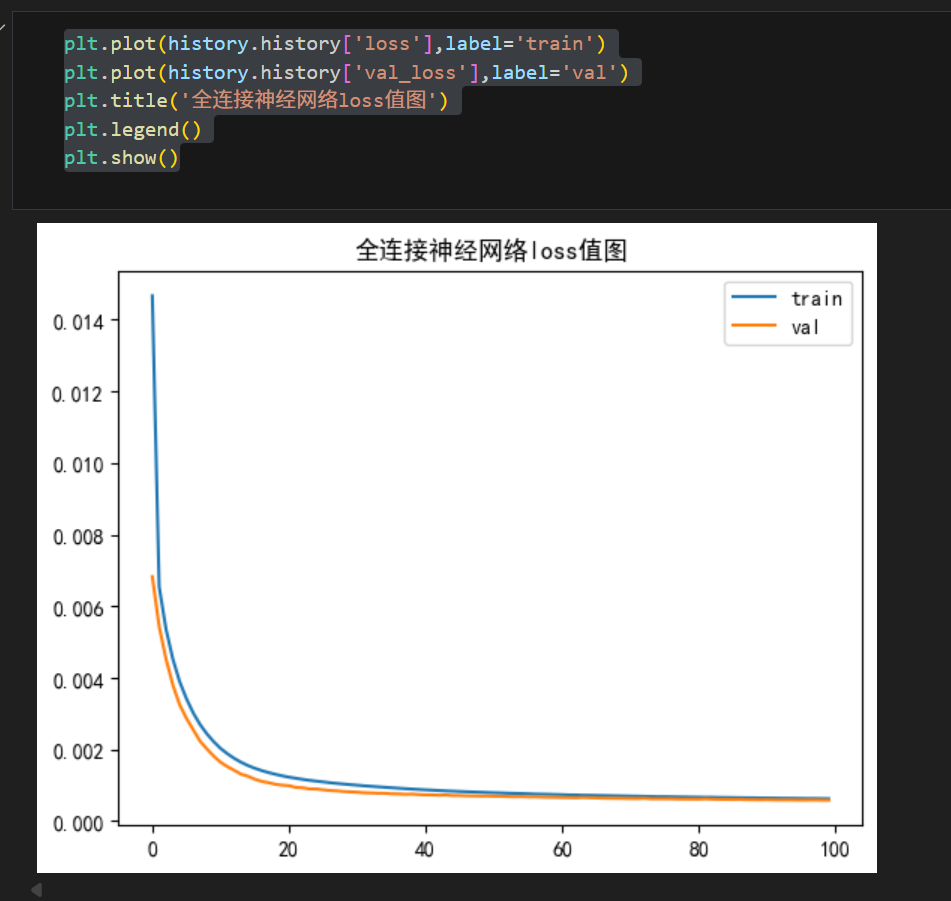
四、模型检测
再新建一个aqi_test.ipynb,前面的步骤其实和aqi_train的代码差不多,你们直接粘贴文件来改也是可以的
1、导包
import numpy as np
import pandas as pd
import matplotlib.pyplot as plt
from sklearn.preprocessing import MinMaxScaler
from sklearn.model_selection import train_test_split
# import keras
# from keras .layers import Dense
from tensorflow.python.keras.utils.np_utils import to_categorical
from sklearn.metrics import classification_report
plt.rcParams['font.sans-serif']=['SimHei'] # 用来正常显示中文标签
plt.rcParams['axes.unicode_minus']=False # 用来正常显示负号
import warnings
warnings.filterwarnings("ignore")
from sklearn.metrics import mean_squared_error
from keras.models import load_model
from tensorflow import concat as concatenate # TF 风格
2、导入数据集
dataset = pd.read_csv('aqi.csv')
dataset
3、划分特征与标签
X = dataset.iloc[:,1:-1]
Y = dataset['AQI']
4、划分训练集和测试集,这里我们划分为8:2
x_train,x_test,y_train,y_test = train_test_split(X,Y,test_size=0.2,random_state=42)
5、数据归一化(这里就不太一样了,一起归一化的话不太好)
x_scaler = MinMaxScaler()
y_scaler = MinMaxScaler()
x_train = x_scaler.fit_transform(x_train)
x_test = x_scaler.transform(x_test)
y_train = y_scaler.fit_transform(y_train.values.reshape(-1, 1))
y_test = y_scaler.transform(y_test.values.reshape(-1, 1))
6、导入训练好的模型
model = load_model('aqi_model.keras')
7、将数据反归一化,先出来模型预测结果,然后把模型结果反归一化,因为你之前把数据归一化为了范围0-1的数据,但是我们与真实数据进行比较的时候是要用归一化之前的正常值的,所以这里我们要进行反归一化的操作。
yhat = model.predict(x_test)
inv_yhat = y_scaler.inverse_transform(yhat)
# 反向缩放真实值
inv_y = y_scaler.inverse_transform(y_test)
inv_y
8、模型评估,这里就要用均方误差了,可以看到均方误差大约为3.08,这样看我们的模型效果还是蛮不错的
import math
rmse = math.sqrt(mean_squared_error(inv_y,inv_yhat))
mape = np.mean(np.abs(inv_y - inv_yhat)/inv_yhat)
print('rmse',rmse)
print('mape',mape)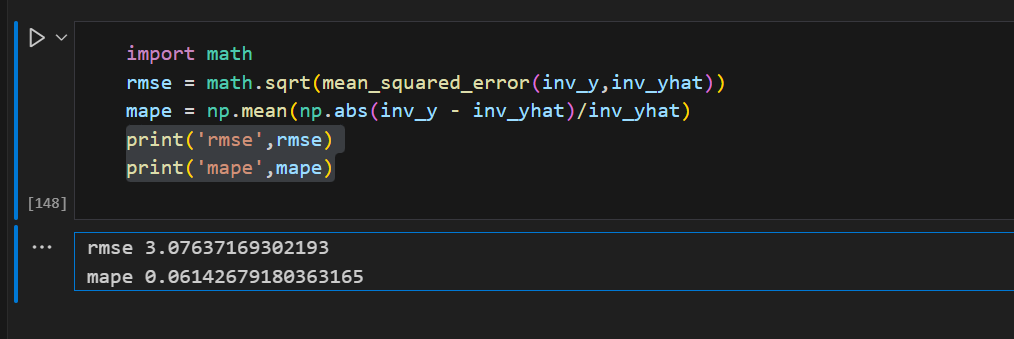
最后可视化一下,看看真实值和预测值的
plt.plot(inv_yhat,label='预测值')
plt.plot(inv_y,label='真实值')
plt.title('对比图')
plt.legend()
plt.show()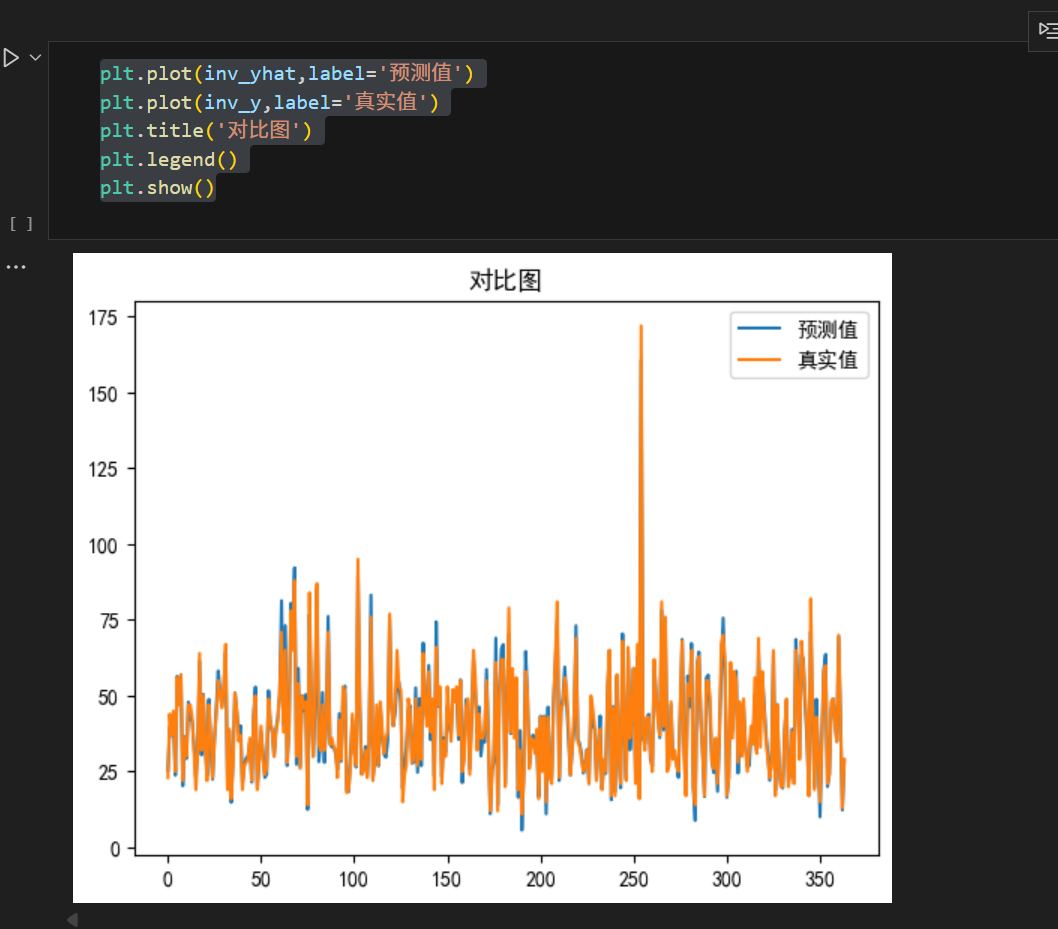
整个全连接神经网络的AQI实战到这里就结束了,需要全部代码的可以看看我的资源,放有完整的代码。
结束,完结撒花~























 447
447

 被折叠的 条评论
为什么被折叠?
被折叠的 条评论
为什么被折叠?








